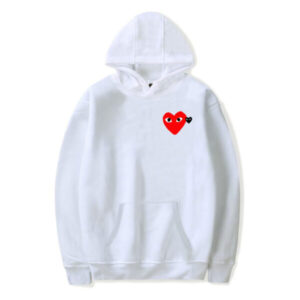The Aesthetic of Subversion: Aesthetic Principles
At the core of Comme des Garçons lies a commitment to subversion. Kawakubo’s designs often embrace asymmetry, deconstruction, and a minimalist color palette, frequently favoring black. This approach is not merely an artistic choice; it is a philosophy that questions the very essence of clothing. By stripping garments of their conventional forms, Kawakubo invites wearers to reconsider what fashion means.
The brand’s runway shows are legendary, often resembling avant-garde performances more than traditional fashion displays. Each collection tells a story, weaving narratives that provoke thought and evoke emotion. Whether it’s the haunting silhouettes or the exaggerated proportions, Comme des Garçons challenges the viewer to engage with fashion on a deeper level, transforming clothing into a form of artistic expression.
Cultural Impact: Breaking Boundaries
Comme des Garçons didn’t just introduce new designs; it ignited a cultural movement. By promoting an anti-fashion ethos, the brand has influenced countless designers and shifted the focus from mere aesthetics to conceptual depth. This impact is particularly notable in the rise of streetwear and the blending of high fashion with everyday attire.
Kawakubo’s influence can be seen in the works of designers such as Raf Simons and Ann Demeulemeester, who have embraced her philosophy of blending art with fashion. The brand has not only paved the way for emerging designers but has also inspired a generation of consumers who value individuality over conformity.
The Iconic Collections: A Retrospective
The Revolutionary 1980s
The 1980s marked a significant turning point for Comme des Garçons. The brand’s collections during this period introduced the world to the concept of “anti-fashion.” The Spring/Summer 1981 collection, with its signature distressed fabrics and avant-garde silhouettes, shocked the fashion establishment and garnered attention on a global scale. It was a bold statement that left behind the conventional glamour of the time, paving the way for a new era in fashion.
The Art of Deconstruction
The concept of deconstruction became synonymous with Comme des Garçons, particularly in the 1990s. Kawakubo’s Spring/Summer 1994 collection, known as “The End of Fashion,” was a groundbreaking exploration of form and function. The collection featured garments that appeared unfinished or inside out, blurring the lines between what is considered beautiful and what is considered flawed. This radical approach resonated with the post-modern ethos of the time, encouraging wearers to embrace imperfections as part of their identity.
The Playful Yet Provocative
Kawakubo’s designs are not solely rooted in darkness; they also explore playfulness and whimsy. The 2010 collection, which featured oversized silhouettes and bold colors, encapsulated a sense of childlike wonder. This juxtaposition of seriousness and playfulness is a hallmark of Comme des Garçons, demonstrating that fashion can be both thought-provoking and fun.
Collaborations that Redefined Fashion
Comme des Garçons has continually embraced collaboration as a means to push boundaries. One of the most notable partnerships has been with Nike, which began in the early 2000s. The result was a fusion of high fashion with athletic wear, exemplified by the iconic Air Presto and Dunk models adorned with Kawakubo’s avant-garde designs. This collaboration not only expanded the brand’s reach but also redefined the relationship between streetwear and high fashion.
Another significant collaboration was with the French luxury house, Hermès, in 2005. This partnership highlighted Kawakubo’s ability to merge her avant-garde vision with traditional craftsmanship. The collection featured deconstructed handbags and reimagined classic pieces, showcasing the versatility of her design philosophy.
Sustainability and Ethical Practices: A Forward-Thinking Approach
In an era where sustainability is becoming increasingly crucial, Comme des Garçons has taken strides toward ethical practices. The brand emphasizes the importance of quality over quantity, encouraging consumers to invest in pieces that transcend trends. Kawakubo’s designs are often timeless, with an emphasis on craftsmanship and durability, thus promoting a more sustainable approach to fashion.
Additionally, Comme des Garçons has been vocal about the need for the fashion industry to evolve in terms of environmental responsibility. The brand has implemented measures to reduce waste and has begun exploring sustainable materials, setting an example for others in the industry.
The Global Phenomenon: Store Locations and Cultural Influence
Comme des Garçons has established flagship stores in major cities around the world, including Tokyo, Paris, and New York. Each location is meticulously designed to reflect the brand’s aesthetic and philosophy. The Tokyo store, for instance, features an avant-garde architecture that mirrors the brand’s innovative spirit.
The brand’s presence in these fashion capitals has further solidified its status as a cultural icon. Events like the annual Dover Street Market pop-up in London serve as a convergence point for fashion enthusiasts, allowing for the exploration of new collections and collaborations in an immersive environment.
The Legacy of Rei Kawakubo: A Lasting Impact
Rei Kawakubo’s influence extends beyond the realm of fashion; she has become a cultural icon in her own right. Her ability to transcend traditional boundaries has inspired countless individuals to embrace their unique identities. In 2017, the Costume Institute of the Metropolitan Museum of Art celebrated her contributions with a retrospective exhibition titled “Rei Kawakubo/Comme des Garçons: Art of the In-Between.” This exhibition not only showcased her innovative designs but also solidified her legacy as one of the most influential designers in contemporary fashion.
Kawakubo’s philosophy emphasizes the importance of individuality and self-expression, encouraging wearers to curate their personal narratives through clothing. This ethos resonates particularly in today’s world, where the desire for authenticity and uniqueness is paramount.
Conclusion: The Future of Comme des Garçons
As we look to the future, Comme des Garçons remains a beacon of creativity and innovation. The brand’s commitment to challenging the status quo ensures that it will continue to shape the fashion landscape for years to come. With emerging designers drawing inspiration from Kawakubo’s work, the legacy of Comme des Garçons will undoubtedly endure, influencing new generations of creators and consumers alike.
In a world where fashion often succumbs to fleeting trends, Comme des Garçons stands firm in its belief that clothing can be a powerful medium for self-expression and a platform for artistic exploration. As Rei Kawakubo once said, “Fashion is about change.” And through her visionary work, she has ensured that change will continue to inspire and provoke thought within the fashion industry Read More: Big Back Meaning: From Origins to Popular Usage in Social Media










